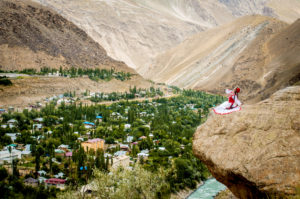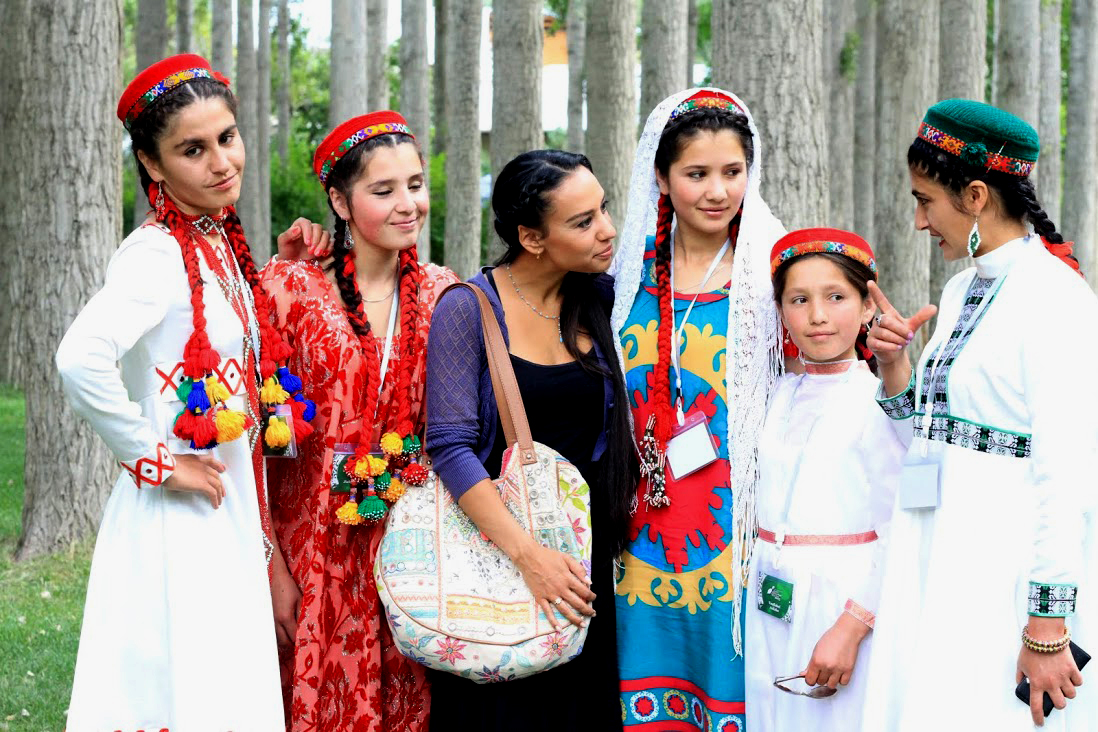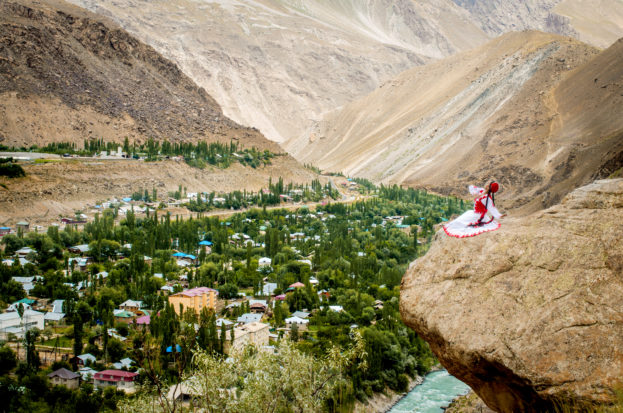
When Tara Catherine Pandeya first landed in Tajikistan last year, she only planned to spend a month in the country. Almost 11 months later, she lives in Dushanbe, Tajikistan’s capital, and is the first Westerner to be part of the National Ensemble, a group of 30 dancers who practice and perform dances from Central Asia.
Half Indian, half German-American, Pandeya grew up in a multicultural household in Marin County, California. Her mother, Barbara Framm, is a dance artist who has been practicing and performing the classical Indian dances of Bharatanatyam and Odissi for close to 40 years. Pandeya was making up movements and entertaining her family by performing dance routines for as long as she can remember. She has been dancing since she was three, beginning with Indian classical dance, before learning and performing tap dance as an eight-year old. She joined the Middle Eastern dance troupe “Aywah!” as a teenager, and started performing Central Asian dance at age 16, with Ballet Afsaneh.
Central Asia is made up of the five republics of Kazakhstan, Kyrgyzstan, Tajikistan, Turkmenistan and Uzbekistan, once all part of the former Soviet Union, and situated on the old Silk Road, the ancient trade route that connected Asia to Europe. Although dances from these countries vary in styles and forms, they have some overlapping characteristics, such as intricate arm and hand movements, spins and turns, backbends, shoulder isolations and facial expressions. Some include kneeling on the floor and complex footwork.
The dances divide themselves between the classical traditional forms that originated in the courts of Central Asia, and the folk styles, which are specific to each region. “In my opinion, those dances are reflective of the environment they spring from,” shared Pandeya, who was reached by phone from Dushanbe. “For example, in Tajikistan, in the region of Kulyab, dancers wear brightly embroidered tulips and long, [ample] sleeves. They have very expansive movements and that region happens to be very at and expansive. In the Pamirs, the mountains are omnipresent and there are lots of springs and waterfalls, so the movements are slow and very fluid.”
Traveling across the globe is not new for Pandeya, who visited over 50 countries as a principal dancer with Cirque du Soleil. For over four years, she played the lead character role of Océane, the goddess of water, in Dralion. She came to Tajikistan to deepen her understanding and practice of the classical Tajik dance form. “I feel at home in this style of dance. When my teachers teach it to me, they are pulling something out of me which is already there, versus putting something into me that is [foreign.] This might partly be because Central Asia is right in the middle of the Eastern and Western parts of the world and, with my cultural heritage, it is where I find my center.”
In the process of documenting and deepening her knowledge of Central Asian dance, Pandeya has to rely on kinesthetic memory as some teachers do not allow video recording. She also draws notations of the different dances with stick figures. “I’m dancing six hours everyday, so it is solidifying my muscle memory. With Cirque, we were doing 10 shows a week but it was the same show and the same character for four and a half years. Here the artistic director is constantly creating new pieces for new events. So I really need to compartmentalize tons of different choreography,” Pandeya explained.
She notices a strong respect for tradition in the forms that she is learning today. The movements are quite similar to those performed 50 years ago, recorded in well-preserved video footage from the Soviet era. Yet, as with any traditional art form that has been taught from one generation to the next, the dances evolve. “Every dancer interprets movements and music differently. The same goes for choreographers. The artistic director of our company is creative and experimental with storytelling, mixing new with old concepts, or mixing folk styles from different regions into one piece to promote pluralism. There was a civil war here [between 1993 and 1998] and a lot of fighting between different regions. Having dances from different regions featured in one piece is an important image to present to the public, to promote mutual appreciation and acceptance.”
Fostering mutual understanding and serving communities are the ultimate goals of art for Pandeya. After a year dancing Océane, she missed the experience of performing in and for the community, with a strong cultural and social emphasis. So she took advantage of the Cirque du Monde’s social project and became their social outreach liaison. In that role, she organized workshops where dancers and clowns taught circus arts to Lebanese and Palestinian refugees’ children in Lebanon, or to children with HIV in South Africa. This more personal interaction with the community within which she was residing for one to two weeks was “much more fulfilling than living in a hotel, going to an arena and not being engaged with the local population,” Pandeya shared.

She views dance as a bridge between people and a way to cast light on world cultures that are often marginalized. “People in Central Asia, at least in Tajikistan, are some of the most hospitable and generous people that I have ever met in my life. I feel a heightened responsibility to promote positive visibility through the art that I create, because it is unfortunately a region that is often misunderstood, completely unknown, or misrepresented through negative media.”
Pandeya is also passionate and eager to share the rich artistic and cultural diversity that has unknowingly influenced the rest of the world: “The cultures of Central Asia are steeped in performing arts. Dance and music are a huge part of the cultural identity here. Some of the greatest ballet directors are from Central Asia. Robert Joffrey’s father was from Afghanistan. Nijinsky’s Rite of Spring was based on movements he pulled from paintings from Tajikistan. I think ballet, modern and contemporary dance are all beautiful forms but they are given this heightened respect. Central Asian dance is a 2000 year-old tradition and is equally complex, detailed and nuanced and it takes a lifetime to dedicate yourself to. Most people have no clue what it looks like and think it is a folk dance that is easy to pick up. I want to help bring it into the dance world and get it the credit and respect that it deserves.”
Pandeya was recently awarded an Asian Cultural Council grant to research the relationship between Central Asian dances and North Indian classical Kathak. She has been doing some groundwork in Tajikistan and will soon fly to London to work with renowned classical Kathak artist Nahid Siddiqui, who splits her time between Pakistan and England.
For Pandeya, Central Asian dance and classical Indian dance share a lot of similarities, notably in the instrumentation, jewelry and costuming, as well as in the depiction of dancers that appear in the miniatures paintings from the Mogul period. “During that time, most of kings and queens who lived in India were of Central Asian origins. They imported a lot of dancers from Central Asia. Kathak dance is one of the only classical forms in India that has the rapid spinning, like the Sufi spinning, which comes from Central Asia.”
When I spoke with Pandeya, the National Ensemble of which she is a part of was preparing to perform during the national celebrations of the day of Tajik Independence, on September 9. After that, Pandeya will bid farewell to Tajikistan to travel to London and study with Siddiqui, before returning to the States, where she foresees her research culminating in a collaborative piece utilizing Central Asian and Kathak dances. Once back home, she will continue to share the artistic wealth these practices bring forth, bridging the gap between East and West one dance at a time.


